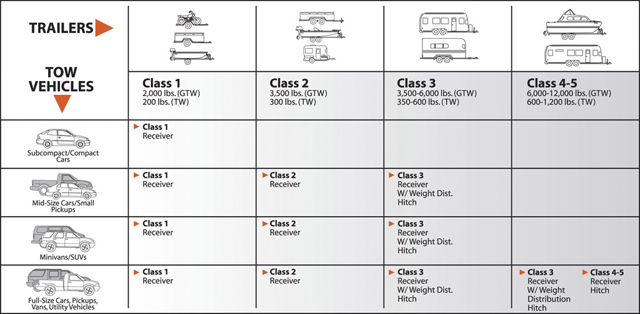
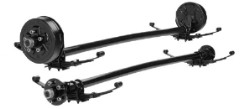 Leaf Spring Axles
Leaf Spring axles utilize high strength steel spindles welded to high strength tubing to form an axle beam. The spindles are usually available in either a straight or drop design to help designers establish the desired frame height or ground clearance. Leaf springs are attached to the axle using u-bolts and can be positioned either under or over the tube. Use under mounted springs (underslung) to lower the frame height and over mounted springs (overslung) to raise the frame height.
Leaf Spring Axles
Leaf Spring axles utilize high strength steel spindles welded to high strength tubing to form an axle beam. The spindles are usually available in either a straight or drop design to help designers establish the desired frame height or ground clearance. Leaf springs are attached to the axle using u-bolts and can be positioned either under or over the tube. Use under mounted springs (underslung) to lower the frame height and over mounted springs (overslung) to raise the frame height.
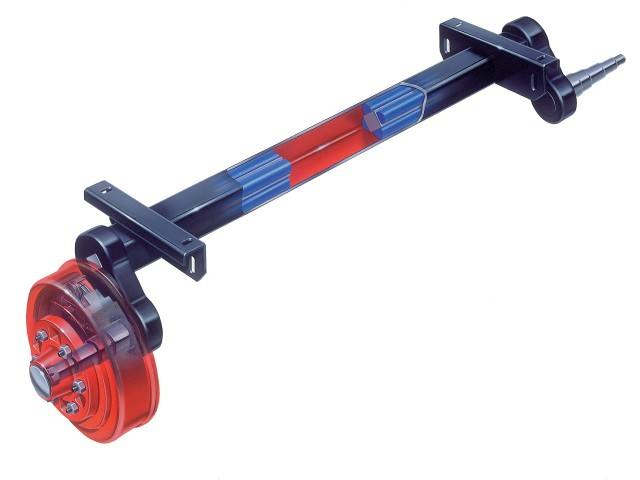 Torsion Axles
Torsion axles are designed as a completely self-contained axle and suspension system. This trailing arm type torsion axle employs natural rubber cords supporting heat treated inner bars of solid, medium carbon steel. Press-fitted and welded to the ends of this independently floating bar are high strength steel torsion arm/spindle assemblies. These arms can be specified to a range of starting angles, which allow the designer to tailor the running height of the vehicle.
Torsion Axles
Torsion axles are designed as a completely self-contained axle and suspension system. This trailing arm type torsion axle employs natural rubber cords supporting heat treated inner bars of solid, medium carbon steel. Press-fitted and welded to the ends of this independently floating bar are high strength steel torsion arm/spindle assemblies. These arms can be specified to a range of starting angles, which allow the designer to tailor the running height of the vehicle.
 Style Type 1
Used for vehicle and trailer equally level towing
Style Type 1
Used for vehicle and trailer equally level towing
 Style Type 2
Used for vehicle and trailer NOT equally level towing
Style Type 2
Used for vehicle and trailer NOT equally level towing
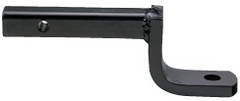 Style Type 3
Straight Cut
Style Type 3
Straight Cut
A permanent hitch ball and bracket that are welded or bolted directly to the tow vehicle. Can be a fixed tongue hitch, which includes the ball and platform or a receiver style with a removable draw bar.
The steel loop on the front of a boat that the bow-strap hook attached to.
The plastic wheel above the bow strap that provides a positive forward stop for a boat on a trailer.
The strap with the hook used to pull the boat tightly up against the bow roller.
Necessary when towing trailers with electric brakes. Electronic module inside the tow vehicle that control electric trailer braking based on inertia or a time delay from brake activation.
The measurement from the rearward-most portion of the cab to the center point of the hitch ball or coupler, which is located directly above or slightly forward of the rear axle. Standard requirements for a full-size bed are a minimum of 48 inches behind the cab. For using a short-bed pickup (less than or equal to 6 feet) to pull a fifth-wheel, the measurement can be as little as 38 inches with a pin box extensions (12-18 inches) and slide rails for the coupler.
Always keep your load balanced front/back & side/side as not to have too much or too little weight on the tongue. The tongue weight should never exceed 10% of the Gross Towing Weight.
Trailer hitch with a capacity up to 2,000 pounds gross trailer weight, with up to 200 pounds of tongue weight.
Trailer hitch with a capacity up to 3,500 pounds gross trailer weight, with 300 to 350 pounds of tongue weight.
Trailer hitch with a capacity up to 5,000 pounds gross trailer weight with 500 pounds of tongue weight.
Trailer hitch with a capacity up to 10,000 pounds gross trailer weight, with 1,000 to 1,200 pounds tongue weight.
Fifth wheel or gooseneck trailer hitch.
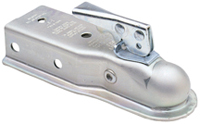
Also called wet weight, curb weight is the weight of a fully fueled vehicle, with all fluids, and no passengers or cargo on board.
The bar to which the hitch ball attaches. Comes in 1¼-inch and 2-inch square configurations depending on hitch class.
A Class V hitch that mounts in the bed of a pickup truck. Although much smaller, the fifth-wheel system is similar in design to those used on tractor trailers.
A Class V hitch that mounts on a ball in the bed of a pickup truck to engage a coupler on a trailer. Ball sizes can be 2 5/16-inch or 3-inch.
Is the maximum permissible combined weight of the tow vehicle and the trailer together when they are fully loaded for travel.
The maximum weight that any axle can support, as published on the Certification / VIN label on the front left side of the trailer. Actual weight determined by weighing each axle on a public scale, with the trailer attached to the towing vehicle.
Is not a rating, it is the actual maximum weight of the tow vehicle when it is fully loaded including all options, cargo, personal belongings, food, water and LP gas.
Is the maximum weight of the fully loaded trailer, as published on the Certification / VIN label. Actual weight determined by weighing trailer on a public scale, without being attached to the towing vehicle.
The downward force exerted on the hitch ball by the trailer coupler.
Always try to maintain the trailer coupler & vehicle hitch in a level position to help minimize fishtailing. Fishtailing refers to the erratic side to side movement of the trailer. It is important when towing a trailer whether it is a bumper pull or a gooseneck style to achieve a level position when loaded. The reason for this is that you want to have an even weight displacement on the axles. For example, if the trailer is to high in the front excessive stress may be applied to the rear axle and/or if the front of the trailer is to low the front axle may become stressed. In extreme cases this can lead to axle failure due to overloading. When hitching up to an unloaded trailer we recommend having the trailer set up slightly higher in the front to allow for settling once the trailer is loaded. Further adjustment of trailer front height may be required as load conditions change.
The sum of curb weight, accessory weight, vehicle capacity weight, and production options weight.
The weight of passengers and cargo carried. Does not include vehicle or trailer weight, but it does include the tongue weight of the trailer. Equal to the difference between GVWR and curb weight.
For securing all ball mounts to receiver style hitches. Hitch Locks protect against ball mount theft.
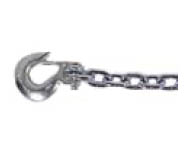
The strength rating of each length of safety chain or its equivalent and its attachments shall be equal to or exceed in minimum breaking force the GVWR (Gross Vehicle Weight Rating) of the trailer.
This is the maximum weight your trailer hitch can handle of the downward force exerted on it by the trailer's tongue (the arm that extends from the trailer that couples with the tow vehicle's receiver). A properly loaded trailer should have 60 percent of the weight piled in front of the axle. An unhitched trailer should lean forward, with its tongue touching the ground. The gravitational force that pushed the trailer downward still exists after the trailer is hitched to a tow vehicle.
The most important connection from the hitch to the trailer. There are many factors that determine the correct hitch ball, (1) most important is the hitch ball's gross trailer weight rating; (2) the mounting platform must be at least 3/8" thick; (3) the hole diameter must not be more than 1/16" larger than the threaded shank; and (4) every time you tow, check the nut and lock washer to make sure they are fastened securely.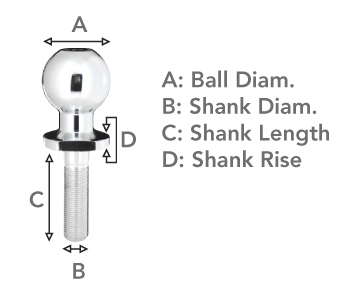
is the actual weight of the tow vehicle or trailer as built at the factory. The UVW does not include passengers, cargo, dealer installed options, personal belongings, water, or LP gas.
Make sure your tow vehicle is capable of towing the intended trailer or accessory. The trailer or accessory and the vehicle work together in determining the maximum capacity. In no case should the GTW or TW exceed the towing capacity of your vehicle, your trailer or your accessory. Find this information in the vehicle owners manual, look under “tow ratings.”
Also referred to as sway bars or leveling bars are designed to increase the capacity of the towing system when added to a Class III, IV or V trailer hitch. The idea is to distribute the load of the trailer evenly to the entire tow vehicle and trailer wheels. To accomplish this, spring bars are used to absorb load and level the trailer. This offers a more level ride, improved steering and increased braking control, all the while enhancing towing safety.
Trailer lights, Electric Brakes, Break-away systems - Every time you tow, be sure to check that all components are working properly. The following chart identifies wiring by color:

HITCHSHOPS.COM
Sales Office
581 Smith Cemetery Rd
Winder, GA 30680
P: 954-224-5584
Email: ken@hitchshops.com
